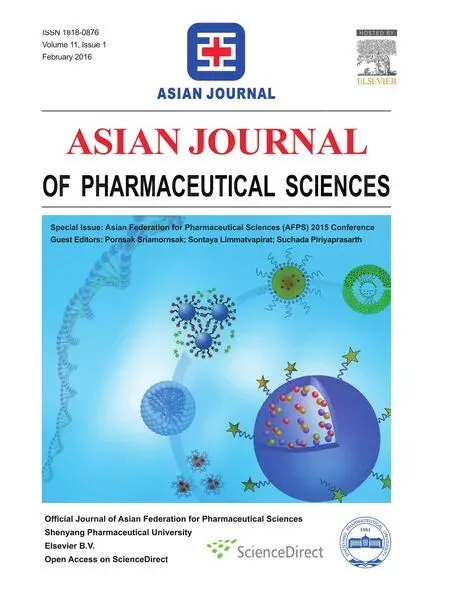Modern characterization techniques for pharmaceutical substances and products
Mont Kumpugdee-Vollrath
Laboratory Chemical and Pharmaceutical Technology,Beuth Hochschule für Technik University of Applied Sciences Berlin,Germany
Modern characterization techniques for pharmaceutical substances and products
Mont Kumpugdee-Vollrath*
Laboratory Chemical and Pharmaceutical Technology,Beuth Hochschule für Technik University of Applied Sciences Berlin,Germany
A R T I C L E I N F O
Article history:
Available online 23 November 2015
SAXS
PCS
TEM
Fishes
Reptile
Liposomes
SEDDs
Emulsion
The modern characterizing techniques,which were used for the determination of the structure of pharmaceutical substances and products in this presentation,were small angle X-ray scattering(SAXS),photon correlation spectroscopy(PCS) and transmission electron microscopy(TEM).
Different pharmaceutical substances and products such as model membranes from fshes,reptiles or carrier systems such as liposomes,emulsion,and self-emulsifying drug delivery systems(SEDDs)were characterized in our group by using SAXS from a synchrotron source.The SAXS technique from the synchrotron source in Hamburg(Deutsches Elektronen-Synchrotron–DESY-HASYLAB)was applied because the synchrotron source has a higher intensity and a very focused X-ray.Very complex information about the structure up to the nanoscale and statements about characteristics at different conditions can be determined.The liposomes prepared from different phospholipids e.g.Phospholipon?90G,90NG,and 85G(Phospholipid GmbH)by a flm method were studied[1].The effect of different model drugs,i.e.paracetamol and acetylsalicylic acid on a liposome bilayer system,was determined.An X-ray scattering model,developed for multilamellar liposome systems,has been used to ft the experimental data and to extract information on how structural parameters,such as the number and thickness of the bilayers of the liposomes,thickness of the water layer in between the bilayers,and size and volume of the head and tail groups,are affected by the drugs and theirconcentration.Even though the experimental data reveal a complicated picture of the drug–bilayer interaction,they clearly show a correlation between nanostructure,drug and concentration in some aspects.The emulsion and SEDD systems were also characterized to understand the mechanism of formation.We have found that the size and size distribution of particles in SEDDS were in nanometers[2].In some cases,the inner structure of SEDDS was ordered with the lamellar distances(dspacing)of<20 nm.It seems that the prepared SEDDS in water formed large oil drops(200–400 nm)as well as small micelles with the droplet size of 10–20 nm.However,the other SEDD or emulsion systems did not show any lamellar phase or liquid crystalline.These emulsions were formed without any ordered structure.The differences of model membranes will be also demonstrated[3,4].In summary,the results from the modern characterizing techniques show promising data.The information can be used as basic knowledge for better understanding of the nanostructure and for better formulation or selection of the pharmaceutical products or model membrane.
Acknowledgements
The author would like to thank Mr.Mario Helmis for the preparation of data,co-workers for performing the experiments and Zentrales Innovationsprogramm Mittelstand(ZIM)–The German Federation of Industrial Research Associations(AiF)for the fnancial support.
R E F E R E N C E S
[1]Nasedkin A,Davidsson J,Kumpugdee-Vollrath M. Determination of nanostructure of liposomes containing two model drugs by X-ray scattering from a synchrotron source.J Synchrotron Radiat 2013;20:721–728.
[2]Kumpugdee-Vollrath M,Weerapol Y,Schrader K,et al. Investigation of nanoscale structure of self-emulsifying drug delivery system containing poorly water-soluble model drug. Adv Mater Res 2014;970:272–278.
[3]Wonglertnirant N,Ngawhirunpat T,Kumpugdee-Vollrath M. Evaluation of skin enhancing mechanism of surfactants on the biomembrane from shed snake skin.Biol Pharm Bull 2012;35(4):1–9.
[4]Kumpugdee-Vollrath M.Determination of secondary nanostructure of model membrane from local fshes for application in pharmaceutical feld.Acta Physica Polonica A 2015;127(4):1240–1242.
*E-mail address:vollrath@beuth-hochschule.de.
Peer review under responsibility of Shenyang Pharmaceutical University.
http://dx.doi.org/10.1016/j.ajps.2015.10.011
1818-0876/?2016 The Author.Production and hosting by Elsevier B.V.on behalf of Shenyang Pharmaceutical University.This is an open access article under the CC BY-NC-ND license(http://creativecommons.org/licenses/by-nc-nd/4.0/).
 Asian Journal of Pharmacentical Sciences2016年1期
Asian Journal of Pharmacentical Sciences2016年1期
- Asian Journal of Pharmacentical Sciences的其它文章
- Determination of the antidepressant effect of mirtazapine augmented with caffeine using Swiss-albino mice
- Photosafety testing of dermally-applied chemicals based on photochemical and cassette-dosing pharmacokinetic data
- Biopharmaceutics classifcation system(BCS)-based biowaiver for immediate release solid oral dosage forms of moxifoxacin hydrochloride (Moxifox GPO)manufactured by the Government Pharmaceutical Organization(GPO)
- Bioequivalence study of abacavir/lamivudine (600/300-mg)tablets in healthy Thai volunteers under fasting conditions
- Evaluation of cytotoxic and infammatory properties of clove oil microemulsion in mice
- Analytical method development of pregabalin and related substances in extended release tablets containing polyethylene oxide
